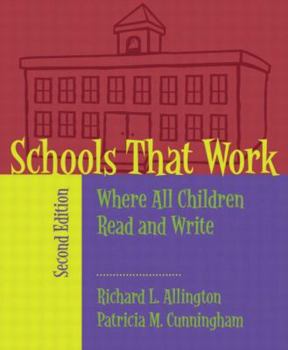Schools That Work: Where All Children Read and Write
Select Format
Select Condition 
Book Overview
Schools That Work provides critical insight into how elementary schools must change to meet the increased demands of education for the 21st century. KEY TOPICS: The authors dynamic analysis of... This description may be from another edition of this product.
Format:Paperback
Language:English
ISBN:080133246X
ISBN13:9780801332463
Release Date:July 2001
Publisher:Allyn & Bacon
Length:302 Pages
Weight:1.14 lbs.
Dimensions:0.6" x 7.5" x 9.1"
Customer Reviews
4 ratings
One of the few truly outstanding education books.
Published by Thriftbooks.com User , 21 years ago
With over ten years as a primary, intermediate, and junior high teacher, I have read lots of education books. This may end up being the book that helps me the most in helping improve myself as an educator, and in helping the school improve itself. This book was jam-packed with great ideas of what truly makes a good school. "Schools That Work" is geared for both principals, teachers, and anyone else in the education field. After reading this it makes for a great reference book. The book is well organized into the different components that make a good school. Also, it has great book, magazine, and web resources throughout the entire book. In short, buy this book without hesitation--it is that good!
A MUST HAVE BOOK
Published by Thriftbooks.com User , 24 years ago
Allington and Cunningham provide excellent insight as to what all schools need to ensure quality instruction to students. This book is a must for all educators, especially administrators. I am a Special Education teacher and a graduate student. I refer to this text often.
Insightful book on how to help all children become literate
Published by Thriftbooks.com User , 25 years ago
With over fifty combined years of experience between them, educational researcher/ consultants Richard Allington and Patricia Cunningham have many ideas to offer in their new book, Schools That Work: Where All Children Read and Write. The book is a natural follow-up to their first collaborative effort, Classrooms That Work: They Can All Read and Write. It is lengthy, but highly engaging, and offers practical, research based ideas for those who envision and want to work toward moving their school or school system toward being one where all children become literate. Because American society has changed, and is changing, at such a rapid pace, Allington and Cunningham contend that the current organizational structure of schools, while being well intentioned, is outdated. Existing structures do not effectively meet the needs of all children, especially those who are at the highest risk of school failure. Therefore, they believe that educational interventions that offer "more of the same" will not work to fix the inadequacies in today's schools. Because many schools are stuck, looking toward traditional solutions, huge amounts of federal and state money are being poured into educational programs such as developmental kindergarten, transitional K-1 classes, retention, and remedial, resource and bilingual programs that aren't effective in helping all at risk learners learn to read and write. Throughout the twelve chapters of the book, examples of effective large and small-scale school restructuring efforts in real schools are described. These descriptions are very helpful in illustrating the authors' key points. Models such as the Coalition of Essential Schools, Success For All, the Accelerated Schools Model, Reading Recovery, School Power and Schools for the 21st Century are included. Chapters of the book are organized around central themes of school organizational plans such as instruction, professional roles, allocation of time, parent involvement, assessment and curriculum materials. I will briefly summarize these chapters to give an overview of their content. In the chapter on curriculum, Cunningham and Allington offer many ideas for getting real reading material into the hands of children. Popular methods of literacy instruction are also described, but it is clear that the authors do not believe there is one best way to teach reading and writing. Instead, they advocate for quality instruction delivered in a multifaceted approach. This position is similar to that taken in Best Practices in Literacy Instruction, edited by Gambrel, Morrow, Neuman and Pressley, a resource text for teachers of literacy. Allington and Cunningham then go on to describe essential components of quality literacy instruction. One of the important points of the book is that "good schools are a collection of good classrooms" and that the job of everyone who works at a school is to support and enhance classroom instruction. An
Another good one!
Published by Thriftbooks.com User , 25 years ago
Because their other book, "Classrooms That Work," is such a hit with my preservice students, I ordered this one. Receiving it just today, and after browsing through and discovering on the final page reference to the the critical words, "common sense initiatives," I have a feeling we may have another winner with this book, as well.





